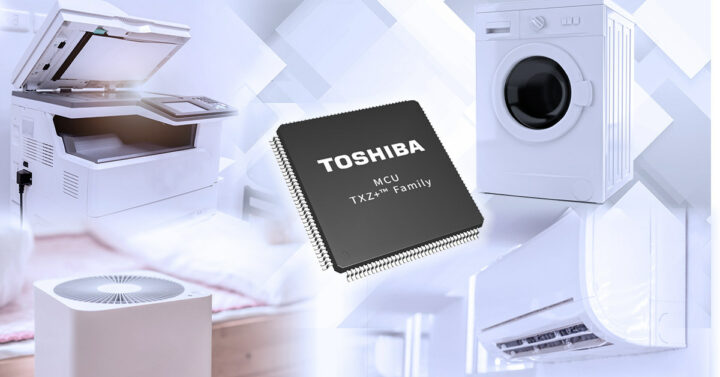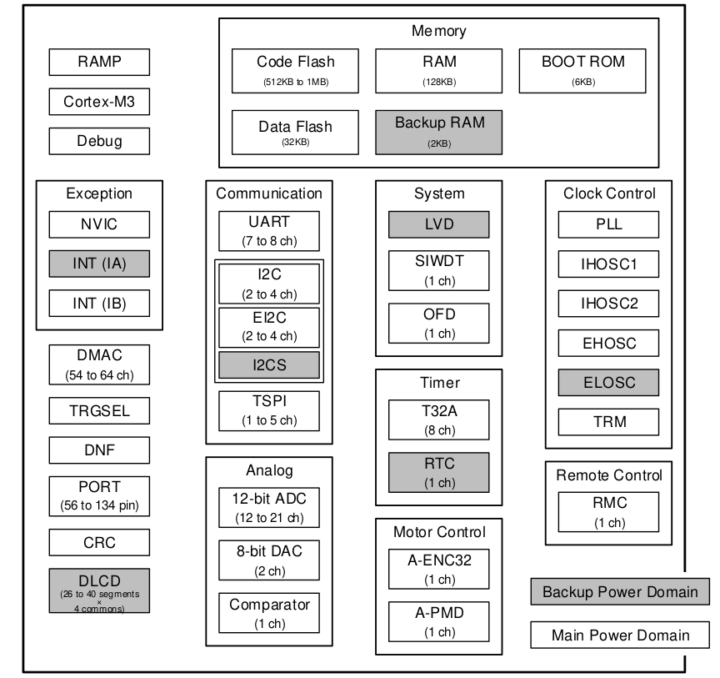Toshiba “MH3 Group (2)” Arm Cortex-M3 microcontrollers come with a 1MB flash memory partitioned into two 512KB partitions to enable firmware updates without interrupting microcontroller operation using an area swap function to rotate to the new firmware seamlessly.
The new M3H Group (2) builds upon the M3H Group(1) by expanding the code flash memory up to 1MB, and the RAM capacity from 66KB to 130KB. Both are part of the “TXZ+ Family Advanced Class” manufactured with a 40nm process, and equipped with a 120 MHz Arm Cortex-M3 core as well as various interface and motor control options such as UART, I2C, Advanced Encoder Input Circuit, and Advanced Programmable Motor Control Circuit.
Toshiba MH3 Group 2 key features and specifications:
- CPU core – Arm Cortex-M3 @ 120 MHz with memory protection unit (MPU)
- Internal oscillator – 10MHz (+/-1%)
- Internal memory
- Code flash memory – 512KB to 1024KB (program/erase cycles: up to 100,000 times). SKUs with 1024KB flash support an area swap method firmware rotation function with two separate code flash areas of 512KB each. Note: not available on the TMPM3HNFDBFG with only 512KB flash
- Data flash memory – 32KB (program/erase cycles: up to 100,000 times)
- 128KB SRAM and 2KB backup RAM with parity
- I/Os – 56x to 134x GPIOs with 12x to 23x external interrupts
- Communication interfaces – Up to 8x UART, up to 4x I2C, up to 5 TSPI
- Analog
- 12-bit ADC – 12x to 21x channels inputs
- 8-bit DAC – 2x channels
- 1x comparator
- Motor control circuits
- Advanced Programmable Motor Control Circuit (A-PMD)
- Advanced Encoder Input Circuit (32-bit) (A-ENC32)
- Other peripheral circuits
- Remote Control Signal Preprocessor (RMC)
- CRC Calculation Circuit (CRC)
- LCD Display Controller (DLCD) – Non-Bias Drive: 40 segments × 4 commons (max) – Note: not available on TMPM3HLF10BUG
- DMA Controller (DMAC) – 2x units, 54x to 64x factors, internal/external triggers
- Timer function
- 32-bit Timer Event Counter (T32A) – 8x channels (16x channels if used as 16-bit timers)
- Real-Time Clock (RTC)
- Watchdog Timer (SIWDT)
- Debugging – JTAG and SWD
- Misc
- Voltage Detection Circuit (LVD)
- Oscillation Frequency Detector (OFD)
- Self-diagnosis functions for IEC 60730 class B functional safety
- Operating voltage – 2.7 to 5.5V, single voltage supply
- Packages
- LQFP144 (20mm x 20mm, 0.5mm pitch)
- LQFP128 (14mm x 14mm, 0.4mm pitch)
- LQFP128 (14mm x 20mm, 0.5mm pitch)
- LQFP100 (14mm x 14mm, 0.5mm pitch)
- QFP100 (14mm x 20mm, 0.65mm pitch)
- LQFP80 (12mm x 12mm, 0.5mm pitch)
- LQFP64 (10mm x 10mm, 0.5mm pitch)
Toshiba M3H Group microcontrollers are used in consumer equipment such as home appliances, toys, and health care equipment, office equipment (e.g. multi-function printers), especially for motor control and IoT functions in both consumer and industrial equipment.
Renesas says documentation, sample software with actual usage examples, and driver software are available, along with evaluation boards and development environments provided in cooperation with Arm ecosystem partners. There are plenty of documents, but I was unable to find specifics about evaluation boards.
Toshiba is currently offering eight different SKUs for the new MH3 Group (2) Arm Cortex-M3 microcontrollers with seamless firmware update support (except for one with only 512KB flash). Some additional details may also be found in the press release.
Thanks to TLS for the tip.

Jean-Luc started CNX Software in 2010 as a part-time endeavor, before quitting his job as a software engineering manager, and starting to write daily news, and reviews full time later in 2011.
Support CNX Software! Donate via cryptocurrencies, become a Patron on Patreon, or purchase goods on Amazon or Aliexpress. We also use affiliate links in articles to earn commissions if you make a purchase after clicking on those links.





